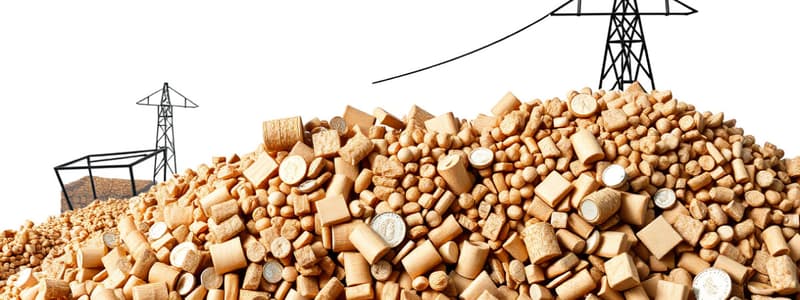Podcast
Questions and Answers
The long run aggregate supply curve is vertical because in the long run, what does it depend on?
The long run aggregate supply curve is vertical because in the long run, what does it depend on?
- Market demand
- Changes in the price level
- The size of the labor force (correct)
- Inflation rates
More capital accumulation will cause the long-run aggregate supply curve to...
More capital accumulation will cause the long-run aggregate supply curve to...
shift to the right
The short-run aggregate supply curve slopes upward because of...
The short-run aggregate supply curve slopes upward because of...
input prices reacting more slowly to changes in final goods prices
What causes the short-run aggregate supply curve to shift to the right?
What causes the short-run aggregate supply curve to shift to the right?
A change in the price level will cause the long-run aggregate supply curve to change.
A change in the price level will cause the long-run aggregate supply curve to change.
An increase in the labor force will cause the long-run aggregate supply curve to...
An increase in the labor force will cause the long-run aggregate supply curve to...
An unexpected increase in the price of an important raw material will...
An unexpected increase in the price of an important raw material will...
What will happen if there is a change in the expected price level?
What will happen if there is a change in the expected price level?
The price level that is currently higher than expected will cause the SRAS curve to _____
The price level that is currently higher than expected will cause the SRAS curve to _____
Which of the following factors is likely to cause the short-run aggregate supply curve to shift?
Which of the following factors is likely to cause the short-run aggregate supply curve to shift?
Flashcards are hidden until you start studying
Study Notes
Aggregate Supply Curve Concepts
- The long-run aggregate supply (LRAS) curve is vertical, indicating that potential GDP is unaffected by price level changes; it depends on labor force size, capital stock, and technology.
- An increase in capital accumulation shifts the LRAS curve to the right, indicating growth in productive capacity.
Short-Run Aggregate Supply (SRAS)
- The short-run aggregate supply (SRAS) curve slopes upward due to slow adjustments in input prices, leading to increased sales for firms when final goods prices rise, and costs such as menu costs delaying price changes.
- The SRAS curve shifts right with increases in labor force, capital accumulation, productivity, and technological advancements.
- The SRAS curve shifts left with higher expected prices of key natural resources, and via adjustments to prior underestimations of price levels or expected future prices.
Price Level Effects
- Changes in the price level affect movement along the SRAS curve rather than shifting it; increases in the price level alone do not change the SRAS curve.
- An increase in expected future prices decreases (shifts left) the SRAS curve, reflecting new expectations about future prices.
Labor Force and Capital
- An increase in labor force shifts the LRAS right due to enhanced productive capacity.
- An increase in capital goods also results in a rightward shift of the LRAS, reflecting improved production capability.
- Technological changes similarly lead to a rightward shift in the LRAS, signifying advancements in productivity.
Price Expectations and Supply Shifts
- Misestimations of future price levels, sticky wages, and adjustment times contribute to the upward slope of the SRAS curve.
- Supply shocks, such as sudden changes in important raw material prices, can unexpectedly shift the SRAS curve leftward.
Incorrect Assumptions
- The economy's potential supply scenarios that incorrectly consider expected price levels to impact LRAS are flawed since they primarily affect SRAS.
Summary of Effects
- An increase in current price levels doesn't shift the SRAS; it leads to movements along the existing curve.
- Unexpected increases in important commodity prices shift the SRAS left, indicating rising costs affecting firms’ supply decisions.
Studying That Suits You
Use AI to generate personalized quizzes and flashcards to suit your learning preferences.




